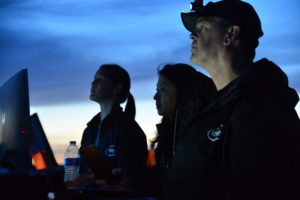 Intel’s Shooting Star Drones have already made the big time. The drone light show – getting bigger and better all the time – has co-starred with Beyonce at Coachella, performed at the Winter Olympics, and was one of the best floor shows in Vegas for this year’s CES show. But the tiny drones – with their sophisticated fleet management system, enabling them to form patterns in the sky – have now achieved an iconic milestone in modern culture: they’ve made the cover of Time Magazine.
Intel’s Shooting Star Drones have already made the big time. The drone light show – getting bigger and better all the time – has co-starred with Beyonce at Coachella, performed at the Winter Olympics, and was one of the best floor shows in Vegas for this year’s CES show. But the tiny drones – with their sophisticated fleet management system, enabling them to form patterns in the sky – have now achieved an iconic milestone in modern culture: they’ve made the cover of Time Magazine.
This week’s issue of TIME is a special report on drones “that explains how they are transforming our world, from lifesaving innovations in healthcare to creating new works of art to the race behind new efforts to secure our skies,” says TIME.
Appropriately, the issue features the first-ever TIME cover shot by a drone. “To create the image, TIME worked with Intel’s Drone Light Show team Astraeus Aerial Cinema Systems to set 958 drones to display the iconic red border and logo of TIME. The result was one of the biggest drone shows ever produced in the U.S.”
You can watch a video of the cover being created and read more about the process here.
 This is the first cover in TIME’s 95-year history that was shot via a drone camera (an Astraeus Aerial drone). Intel reports that the team flew under 400 feet to create the animation measuring 328 feet (100 meters.) Because the animation would be used as an illustration, it had to be tightly formed – leaving no room for error. Avoiding collisions while in-flight, gusts of wind and other elements were also a concern for the light show team.
This is the first cover in TIME’s 95-year history that was shot via a drone camera (an Astraeus Aerial drone). Intel reports that the team flew under 400 feet to create the animation measuring 328 feet (100 meters.) Because the animation would be used as an illustration, it had to be tightly formed – leaving no room for error. Avoiding collisions while in-flight, gusts of wind and other elements were also a concern for the light show team.
The Time edition will cover multiple aspects of drones in our lives: including, says Time, their prevalence.
On how drones are everywhere, TIME’s Alex Fitzpatrick writes: “With any technology, there are certain inflection points when it goes from being something perpetually in the near future to being a part of everyday life. For years, drones have been hovering on the cusp—used by militaries and relatively small numbers of hobbyists but not part of the larger culture…. Civilian uses, however, have long been more promise than reality. That’s finally changing.”
Fitzpatrick continues, “The surge in drone use presents a challenge for regulators…. Developments in artificial intelligence and automation will make it possible to operate massive drone fleets simultaneously, increasing efficiency and greatly expanding their capabilities. First responders envision highways lined with drones ready to zip lifesaving medicine to accident scenes. Global transportation firms are designing helicopter-size versions that could zip people around like flying taxis, Jetsons-style, without a pilot on board. Like it or not, the sky above is about to become far busier.”
In addition, the special report discusses drones in warfare, drones in Hollywood and art, and drones saving lives.

Miriam McNabb is the Editor-in-Chief of DRONELIFE and CEO of JobForDrones, a professional drone services marketplace, and a fascinated observer of the emerging drone industry and the regulatory environment for drones. Miriam has penned over 3,000 articles focused on the commercial drone space and is an international speaker and recognized figure in the industry. Miriam has a degree from the University of Chicago and over 20 years of experience in high tech sales and marketing for new technologies.
For drone industry consulting or writing, Email Miriam.
TWITTER:@spaldingbarker
Subscribe to DroneLife here.







[…] Intel’s Shooting Star Drones have already made the big time. The drone light show – getting bigger and better all the time – has co-starred with Beyonce at Coachella, performed at the Winter Olympics, and was one of the best floor shows in Vegas for this year’s CES show. But the tiny drones – with […] The post Intel’s Drone Light Show Team Takes Cover of Time appeared first on DRONELIFE. See Original Article […]